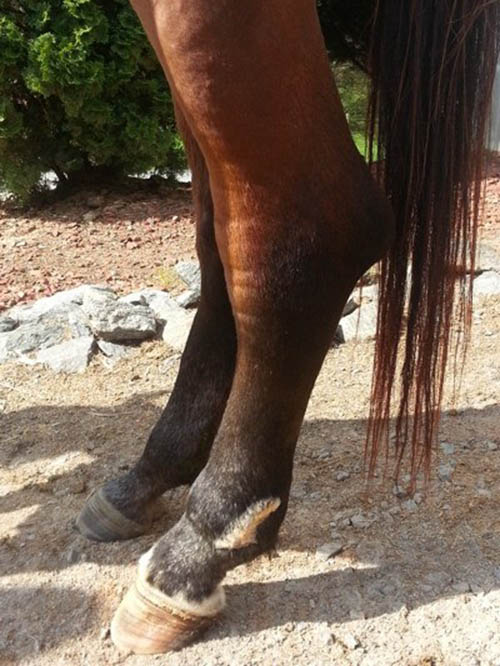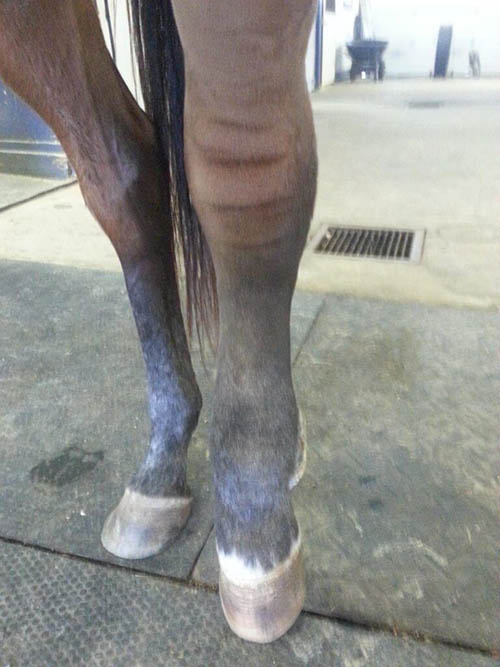Peri-tarsal cellulitis is a unique syndrome that often presents as an emergency due to the severe painfulness of the condition. Basically, it is a cellulitis that starts in the tissues around the hock.
Cellulitis is an infection in the soft tissues under the skin and can occur in any area of the body but is more common in the hind limbs. Often there is a point of entry within the skin for bacteria to gain access to body, and this can be a small wound, an abrasion, or a fine crack in the skin. The unusual aspect of peri-tarsal cellulitis (PTC), however, is that the infection presents as a similar swelling around the hock in all horses affected by the condition and an entry wound for bacteria is seldom identified.
One theory put forward to explain why the hock is predisposed to this condition involves the pattern of the blood vessels that supply the hock and how this predisposes the area to bacteria becoming lodged in the soft tissues, however, this has not been proven.
Horses with PTC present with a sudden-onset severe lameness that, on initial presentation, is often confused with a fracture or an infection of the hock joint because of the swelling localised around the hock joint; it is painful to touch or palpate, with no visible signs of an injury present. Within hours to days, the swelling spreads up and down the leg, resulting in a grossly enlarged hind leg with the horse often refusing to move because of the pain.
A clinical examination should lead the veterinarian towards a diagnosis of an infection, as the rectal body temperature is usually elevated (over 39°C), higher than would be expected with pain associated with a limb fracture. Limb fractures can cause a mild increase in rectal temperature due to pain, but seldom is this over 39°C.
X-RAYS & TESTS
The sudden onset and the degree of pain will prompt some practitioners to X-ray the limb to confirm there is no fracture present. In uncomplicated cases, no fractures will be detected but a large degree of soft tissue swelling will be visible on the X-ray. A blood test will show marked evidence of an infection, however, in most ambulatory situations, results cannot be obtained for several hours after the initial presentation, so treatment is started before a definitive diagnosis can be made.
In some very early cases, the blood inflammatory/infection markers have not had enough time to rise, giving a false negative reading on the initial blood, however, a follow-up blood test should always be performed if the vet believes the leg is infected and the initial blood is inconclusive. The second blood will show marked increases in inflammatory/infection markers, the white cells, the fibrinogen, and the serum amyloid A (SAA) if it is PTC.
The more complex question initially is whether the infection is only in the soft tissues around the joint, or whether it involves the hock joint itself. An ultrasound examination can be helpful to assess the amount and clarity of joint fluid in the hock, however, it is very painful for the horse to undergo this procedure, due to the pressure needed to be applied to the probe on the site to get a good image, requiring most horses to be sedated.
It can be difficult to differentiate between infected joint fluid and a secondary increase in joint fluid that can occur when the tissues around a joint are inflamed. Taking a joint fluid sample can help determine if the joint is involved, but there is a risk associated with inserting a needle into a joint through infected tissues, as bacteria may be transported from the infected soft tissue into the non-infected joint. Personally, if I suspect PTC, I do not perform a joint tap, however, if there has been a history of previous trauma or intra-articular injections into the hock being performed within the preceding month, I would perform a joint tap as the treatment for a joint infection often differs to treatment for PTC.
ANTIBIOTICS & WALKING
Treatment for PTC involves intense, broad-spectrum antibiotics and anti-inflammatory medications, as well as frequently walking the horse once it is comfortable enough to move. If the antibiotics are not strong enough or not used aggressively, then the infection in the leg can spread quickly, resulting in swelling from the fetlock to the stifle. There have been instances where the swelling has been so marked, the stifle becomes 3-4 times its normal size. In cases where the swelling is marked, serum can start to ooze out as the skin is under intense pressure and begins to crack and split, further inflaming the leg and intensifying the pain as this serum that oozes will blister the skin and cause areas of tissue to slough off.
Walking helps the drainage of lymph fluid and blood from the limb back into the bloodstream and lymph vessels to help reduce the size of the leg. Most horses will show an improvement in their lameness as they walk because the pressure within the soft tissues decreases as drainage of lymph and oedema fluid from the soft tissues allows the horse to bend the hock progressively more and more as the pressure eases.
As PTC signs are resolving, it is common for the swelling to move down the limb from the hock to encircle the pastern and fetlock, but I find this a positive sign as the fluid and oedema tend to be resorbed more quickly with walking than it does when the swelling is concentrated around the hock and moving higher towards the stifle region.
Prognosis for PTC is very good when the syndrome is identified and treated promptly. Complications that can occur with this include osteomyelitis (an infection of the bone) of the hock bones; long digital extensor tendon sheath synovitis (infection in the tendon sheath that runs down the front of the hock); laminitis in the opposite hind limb if the horse remains non-weight-bearing in the affected limb for an extended period; and sadly, death if the infection cannot be contained to the limb and the horse becomes septic (uncommon). EQ
YOU MIGHT ALSO LIKE TO READ THE FOLLOWING BY DR MAXINE BRAIN:
Sinusitis: Not To Be Sneezed At – Equestrian Life, April, 2022
Japanese Encephalitis: No Cause For Alarm – Equestrian Life, April, 2022
Hernia Learning Curve – Equestrian Life, March, 2022
Osteochondromas: Benign But Irritating – Equestrian Life, February, 2022
Don’t Forget the Water – Equestrian Life, January, 2022
Understanding Anaesthesia – Equestrian Life, December, 2021
A Quick Guide to Castration – Equestrian Life, November, 2021
Caring for Mammary Glands – Equestrian Life, October, 2021
Sepsis In Foals – Equestrian Life, September 2021
Understanding Tendon Sheath Inflammation – Equestrian Life, August 2021
The Mystery of Equine Shivers – Equestrian Life, July 2021
Heads up for the Big Chill – Equestrian Life, June 2021
The Ridden Horse Pain Ethogram – Equestrian Life, May 2021
The Benefits of Genetic Testing – Equestrian Life, April 2021
Heavy Metal Toxicities – Equestrian Life, March 2021
Euthanasia, the Toughest Decision – Equestrian Life, February 2021
How to Beat Heat Stress – Equestrian Life, January 2021
Medicinal Cannabis for Horses – Equestrian Life, December 2020
Foal Diarrhoea Part 2: Infectious Diarrhoea – Equestrian Life, November 2020
Foal Diarrhoea (Don’t Panic!) – Equestrian Life, October 2020
Urticaria Calls For Detective Work – Equestrian Life, September 2020
Winter’s Scourge, The Foot Abscess – Equestrian Life, August 2020
Core Strengthening & Balance Exercises – Equestrian Life, July 2020
The Principles of Rehabilitation – Equestrian Life, June 2020
When is Old, Too Old? – Equestrian Life, May 2020



